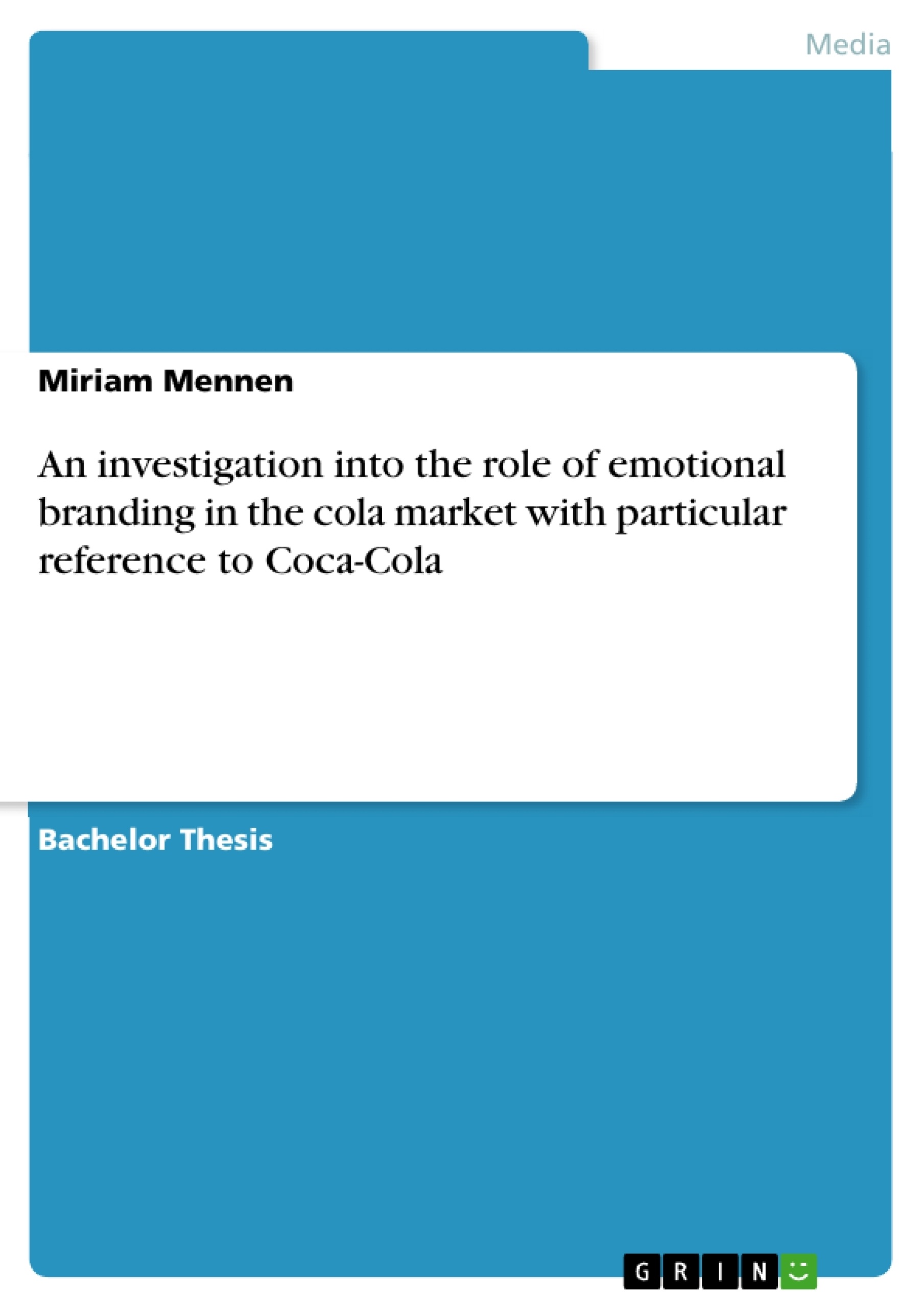The business area of marketing has become increasingly important over the last few decades turning marketing activities into a critical success factor. Emotional benefits in marketing have received more and more attention and discussion because they work beyond the awareness of the customer and influence their buying behaviour.
In an article from the Canadian Marketing Association, Glenn Livingston (2004) says that most of the people do not want to believe that they are or can be emotionally influenced by brands. They do not want to admit to using brands as a method of partially supporting their self-esteem but this is what makes the emotional benefit motivation such an important technique in marketing. It is the case that emotional benefits are so elusive and hidden that it makes them incredibly powerful and persuasive.
Companies like Coca-Cola, Gillette or Victoria’s Secret understand the art of accessing, with intelligence and sensitivity, the true power behind human emotions. They form their brands in a way that they become a face and a character in order to reach the overall aim: the identification of customers with the brand. Today’s most successful brands have built relationships with consumers by engaging them in a personal dialogue that responds to their needs.
In fact, many brands make the mistake of trying to force the emotional benefit by telling the customer directly. As soon as this thought is then put into language and made conscious, a person’s adult mind will make rational decisions and realize that this product does not make them a different person.
As Coca-Cola is the number one on the “Interbrand’s Annual Ranking of 100 of the World’s Most Valuable Brands”, the researcher will take this brand as an example and applies the findings on how consumers are emotionally attached by this brand and how it was able to find its way into consumers’ psyche.
The basic knowledge of marketing and the nature of emotional branding as a specific marketing tool is provided in chapter two through the use of an extensive literature review, which examines the key theoretical perspectives influencing this study.
Inhaltsverzeichnis (Table of Contents)
- PART ONE: INTRODUCTION
- CHAPTER 1: INTRODUCTION
- 1.1 NATURE OF STUDY
- 1.2 AIMS OF STUDY
- 1.3 LIMITATIONS OF STUDY
- 1.4 STRUCTURE OF STUDY
- CHAPTER 2: LITERATURE REVIEW
- 2.1 MARKETING IN GENERAL
- 2.2 ROLE OF CONSUMER BEHAVIOUR
- 2.2.1 THE LOYALTY FACTOR
- 2.3 THE MARKETING MIX
- 2.4 THE BRAND
- 2.5 EMOTIONAL BRANDING
- 2.5.1 TEN COMMENDMENTS OF EMOTIONAL BRANDING
- 2.5.2 FOUR PILLARS OF EMOTIONAL BRANDING
- PART TWO: MAIN BODY
- CHAPTER 3: METHODOLOGY
- 3.1 RESEARCH FAMILIES
- 3.1.1 QUANTITATIVE & QUALITATIVE DATA
- 3.1.2 FIELDWORK & DESKWORK
- 3.2 RESEARCH APPROACHES
- 3.2.1 CASE STUDY
- 3.3 RESEARCH TECHNIQUES
- 3.3.1 DOCUMENTS
- 3.3.2 QUESTIONNAIR
- 3.3.3 INTERVIEW
- 3.4 VALIDITY, RELIABILITY AND GENERALISABILITY
- 3.5 SAMPLING
- 3.6 ETHICAL ISSUES
- CHAPTER 4: FINDINGS
- 4.1 THE GLOBAL BRAND
- 4.2 CONSUMPTION
- 4.2.1 UNITED STATES AS AN EXAMPLE
- 4.3 COCA-COLA
- 4.3.1 COMPETITION
- 4.3.2 ADVERTISING
- 4.3.3 RIVALRY BETWEEN PEPSI AND COCA-COLA
- 4.3.4 THE PEPSI CHALLENGE – BLIND TASTE TEST
- 4.4 EMOTIONAL BRANDING – PLAYING WITH THE SENSES
- 4.4.1 SOUND
- 4.4.2 COLOUR – VISIONARY BRANDING
- 4.4.3 TOUCH - BRANDING THAT FEELS GOOD
- 4.5 BRAND PERSONALITY
- 4.6 WHAT MAKES COCA-COLA SO SPECIAL?
- 4.6.1 THE 'INVENTION' OF SANTA CLAUS
- 4.7 SECRET OF SUCCESS - NOT ‘ONLY' CUSTOMER FOCUS
- 4.8 QUESTIONNAIRES
- 4.9 INTERVIEW
- The evolving role of marketing and the importance of emotional benefits in influencing consumer behavior
- The application of emotional branding principles in Coca-Cola's marketing strategies
- The impact of Coca-Cola's branding on consumer perception and loyalty
- The analysis of Coca-Cola's marketing efforts in relation to its competitors, particularly Pepsi
- The identification of specific emotional branding techniques used by Coca-Cola, such as sensory marketing and brand personality development
- Chapter 1: Introduction: This chapter sets the stage by defining the scope of the research, outlining the aims and limitations of the study, and establishing the structure of the dissertation.
- Chapter 2: Literature Review: This chapter provides a comprehensive overview of relevant theories and concepts, including marketing in general, consumer behavior, the marketing mix, branding, and emotional branding. It explores the key principles and strategies related to building strong emotional connections with consumers.
- Chapter 3: Methodology: This chapter delves into the research methods used in the study, including the research families employed, the research approaches adopted, the research techniques used, and the considerations regarding validity, reliability, and generalisability. It also discusses the ethical considerations involved in the research.
- Chapter 4: Findings: This chapter presents the findings of the research, analyzing Coca-Cola's global brand presence, its consumer base, its competition, and its application of emotional branding techniques. It also examines how Coca-Cola's marketing efforts have shaped consumer perception and influenced their choices.
Zielsetzung und Themenschwerpunkte (Objectives and Key Themes)
This dissertation examines the role of emotional branding in the cola market, specifically focusing on Coca-Cola. It aims to analyze how Coca-Cola has successfully leveraged emotional branding to establish itself as a global icon and connect with consumers on a deeper level. Key themes explored include:Zusammenfassung der Kapitel (Chapter Summaries)
Schlüsselwörter (Keywords)
The primary focus of this dissertation lies in exploring the significance of emotional branding within the cola market, specifically analyzing how Coca-Cola has leveraged this approach to achieve its global success. Key terms and concepts include: emotional branding, consumer behavior, marketing mix, brand personality, sensory marketing, competition, and consumer loyalty.- Quote paper
- Miriam Mennen (Author), 2005, An investigation into the role of emotional branding in the cola market with particular reference to Coca-Cola, Munich, GRIN Verlag, https://www.grin.com/document/145844



